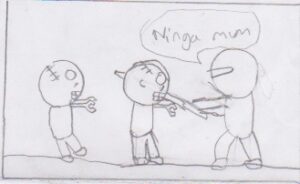How can I stop my children fighting?
It’s no fun living with children who are constantly bickering. Sibling conflict is a common family problem and most families will experience children fighting, arguing, bickering, teasing, and refusing to share at some point or other. But it can really take the joy out of family time and make the most saintly parents wish to be elsewhere.
Some squabbling between siblings is to be expected, but it becomes a problem if it is the usual way children treat each other. If not dealt with effectively, arguing often gets worse or escalates into aggression and physical fighting. Brothers and sisters need to learn to resolve their disagreements and behave in a polite, co-operative and caring way with each other (see Managing sibling conflict: why siblings fight).
Teach sharing and turn taking
Children aren’t born knowing how to share, it’s a skill they have to learn. Just like reading or riding a bike, it takes practice and some children will learn more quickly than others. Parents can encourage sharing, co-operation and turn taking through simple games such as playing cards, ball games or board games. Start by playing these games with your children to show them how to take turns. Praise them for playing co-operatively and give them words to use when things go wrong (“It’s my turn now. Please can I have the ball.”).
Coach problem-solving strategies
Mums are brilliant problem-solvers. The trouble is, we solve problems so quickly that we don’t always model clearly to our children how to solve problems for themselves. Faced with two children fighting over a toy, it’s a simple task for us to assess the situation and come up with a solution.
But if we constantly solve our children’s problems for them, they won’t learn to do it for themselves and we will be needed every time, again and again, to wade in and solve the problem. So investing a bit of time in coaching siblings to solve problems together is a good idea.
Next time you are faced with children fighting over a toy try this:
- Step in immediately, don’t let it escalate. Help them define the problem (“What’s the problem?”). Listen to what they say and summarise it back to them. (“So the problem is you both want to play with the same toy.”)
- Elicit ideas. (“What ideas do you have for solving that problem?”) It’s guaranteed that each child will start with an idea that gives them the toy, but persevere until they come up with some more options. Show them how to take turns in coming up with ideas – offer your own ideas only if they are struggling.
- Prompt them to evaluate the options and select a solution together. Let them agree their own solution regardless of whether you think it is the best option. If they can’t agree, or the process breaks down, take the toy away for five minutes and try again later.
If children learn to make decisions together, the solutions often stick much better than if mum or dad impose a solution. If the solution breaks down then go back and review the decision. (“Was that the best solution? Which other option could you try?”). Gradually withdraw your support for this process as they get the hang of it, reducing the prompts as they learn to solve problems by themselves without calling for you.
Set rules and reward good behaviour
Decide on a few simple house rules to keep the peace. Rules should tell children what to do (rather than what not to do). For example, “Use words to solve problems” or “Use gentle hands” or “Speak in a nice voice.” Back up the rules with lots of praise and maybe a reward chart when you first introduce them. And remember, the house rules apply to all the adults too.
Use assertive discipline
If children start to fight over an activity, tell them clearly to stop, remind them of the rules and prompt them to follow the rules. (“What’s our rule about hands? Show me how you can use gentle hands.”). Remind them to use their problem-solving strategies and praise them if they do. If they can’t, then don’t get into a debate or join the argument, apply a suitable consequence immediately. Take the activity away for five minutes, or use Quiet Time or Time Out for more aggressive behaviour. Use consequences consistently and children will quickly learn that problem-solving is a better route to attention and rewarding solutions than problem-making.
You might also find these Children’s books about sibling rivalry useful for talking about the topic with your children.
This post originally appeared on www.talentedladiesclub.com
Like this? Subscribe to our monthly emails for more tips.







Brilliant advice, as always, Anita! The age gap between my too is quite large (5 years) so there’s been no fighting yet, but I’m ready for it if/when they do! I like what you say about mums solving problems without showing our kids how we did it – I had never thought of that before but now realise that I need to let them learn how to solve their problems and guide them through it. Thanks! #TwinklyTuesday
Thanks Aimee! Lots of siblings go through long periods of getting on really well and not fighting at all too so not all bad news! The problem-solving will help with all areas of life.
Excellent advice! I love that you add adults need to play by the rules too! Children model us for sure. Sometimes with my older children we have a rewind button that allows them to go back and try over again. Stopping by from Twinkly Tuesday. 🙂
I love the rewind strategy, works a treat!
Aah this is a really useful post — really good 🙂 I have twin toddlers and there is often fighting (both verbal and physical) over things. It’s really great to have tools to help try and diffuse these situations. Thanks so much for linking up with us #TwinklyTuesday
Caro | http://www.thetwinklediaries.co.uk
I guess it is unrealistic to expect that siblings will never disagree, but giving them the tools to sort out their disagreements without fists is a real help!